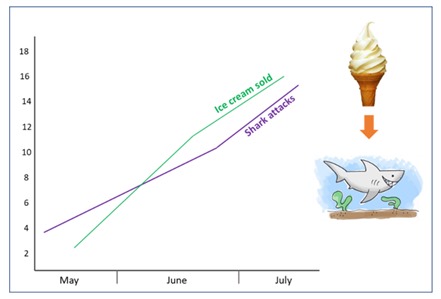Embarking on my professional journey, I found myself immersed in the intricate world of deciphering Helicopter Production Output. The task at hand was clear – identify all potential factors influencing the output and meticulously analyze if a correlation could be drawn. Little did I know, this journey would be a profound lesson in the delicate dance between facts, correlation, and the elusive concept of causation.
In the pursuit of certainties, there were moments of premature celebration, where we believed we had unearthed the incontrovertible facts to substantiate correlations. But, as the wise adage goes, “Correlation does not imply causation.” This timeless lesson was etched into my consciousness after encountering an enlightening article from 2008 that remains as relevant today as ever – a gem http://news.bbc.co.uk/2/hi/uk_news/magazine/7592579.stm
The article artfully unfolds the fallacy of assuming causation merely based on temporal correlation. A vivid example is painted before us: the peculiar relationship between the rise in ice cream sales and an increase in shark attacks. At first glance, it seems almost intuitive to connect the dots – Event A: Ice cream sales surge; Event B: Shark attacks on the rise. The trap lies in assuming that occurrences following an event must be causally linked to it.
Visualizing this misleading correlation is like peering into a graph that showcases the simultaneous ascent of both ice cream sales and shark attacks. It’s easy to fall into the tempting pit of causation, but this is precisely where the narrative takes a compelling twist.
The power of chance, often underestimated, comes to the forefront. The graph tells a story of correlation, but a deeper dive into the interpretation of causes unveils the underlying complexity. It becomes clear that correlation alone is not a ticket to causation; it is merely a dance between variables influenced by numerous factors, both seen and unseen.
This eye-opening experience fundamentally reshaped my approach to data analysis. It taught me the importance of handling data with finesse, steering clear of the allure of simplistic cause-and-effect narratives. In a world where facts reign supreme, it is crucial to acknowledge the intricate tapestry of variables, chance, and nuanced interpretation that governs the true essence of causation.
So, the next time we find ourselves tempted by the illusion of causation within correlated events, let’s pause, reflect, and embrace the complexity that lies beneath the surface. For in the realm of data analysis, unraveling the truth requires more than just facts; it demands a discerning eye and an appreciation for the subtle dance of chance and correlation.

